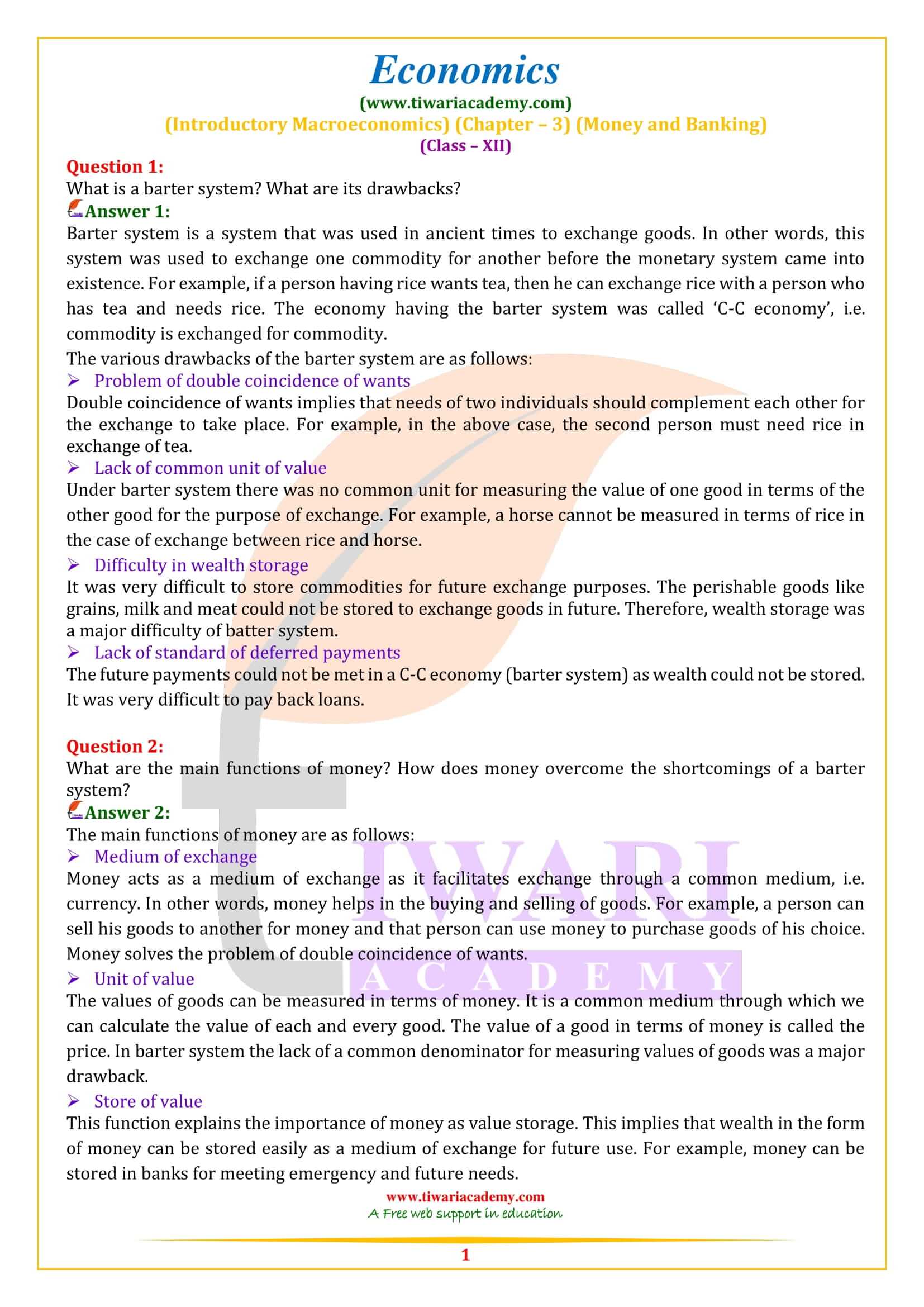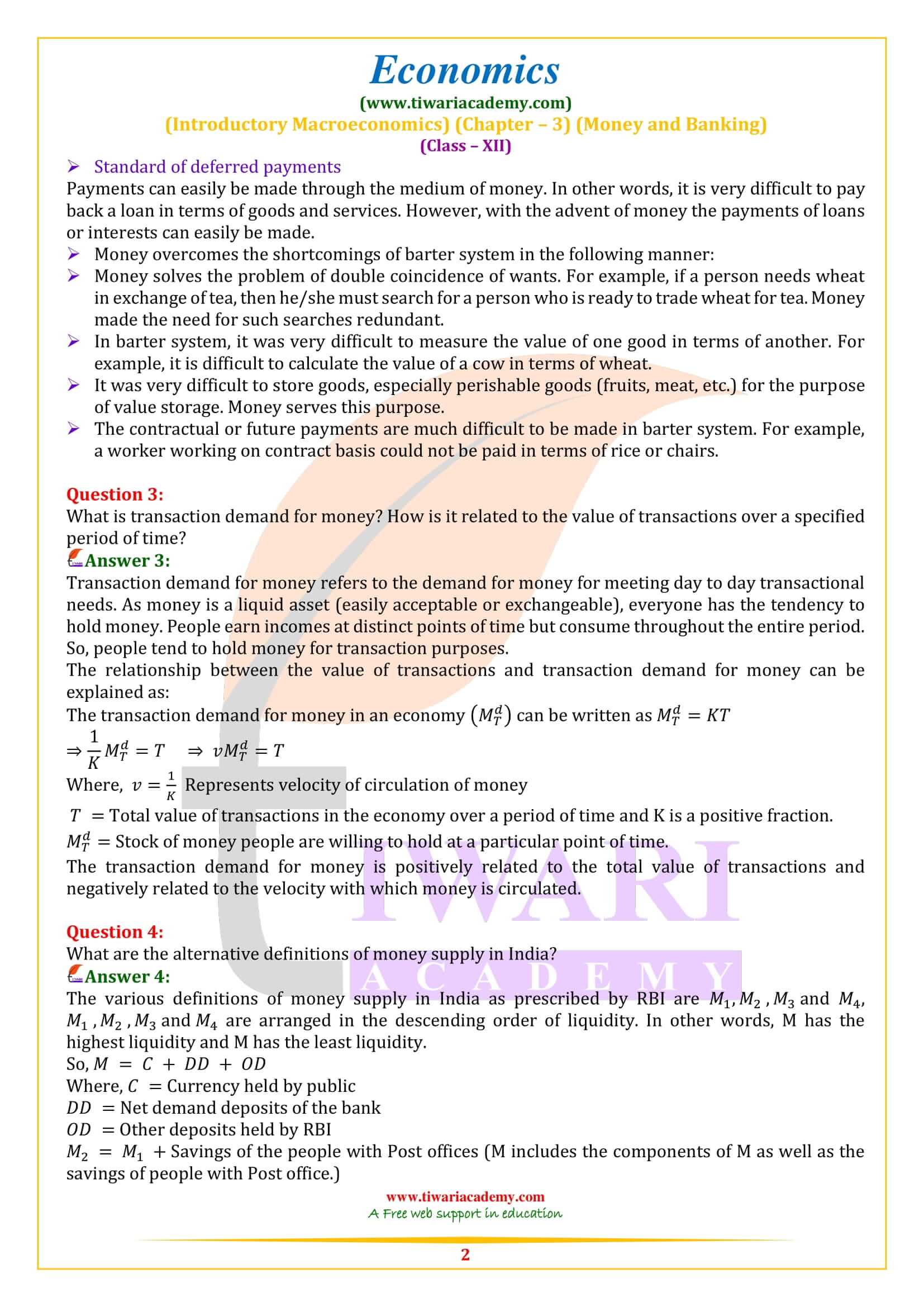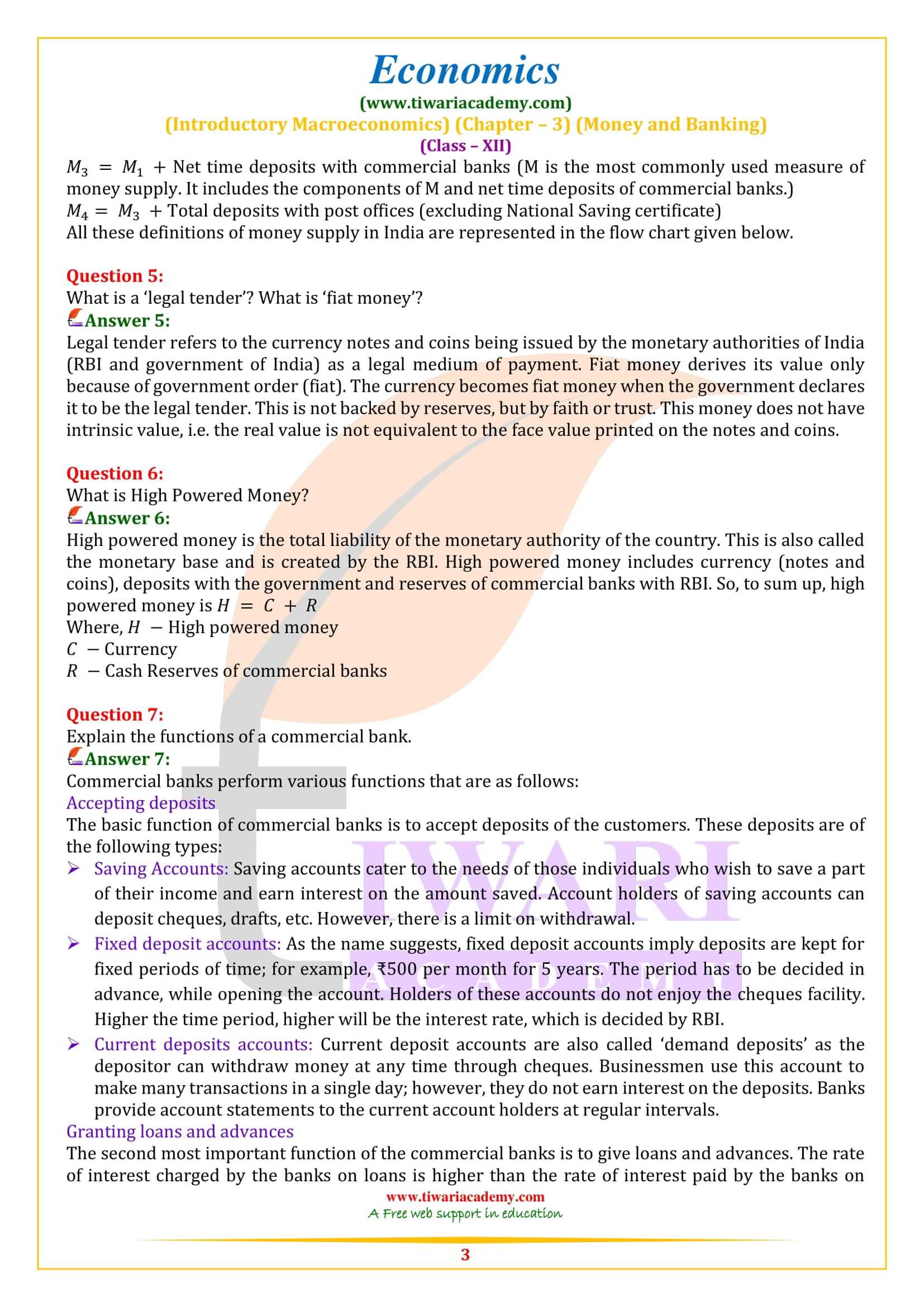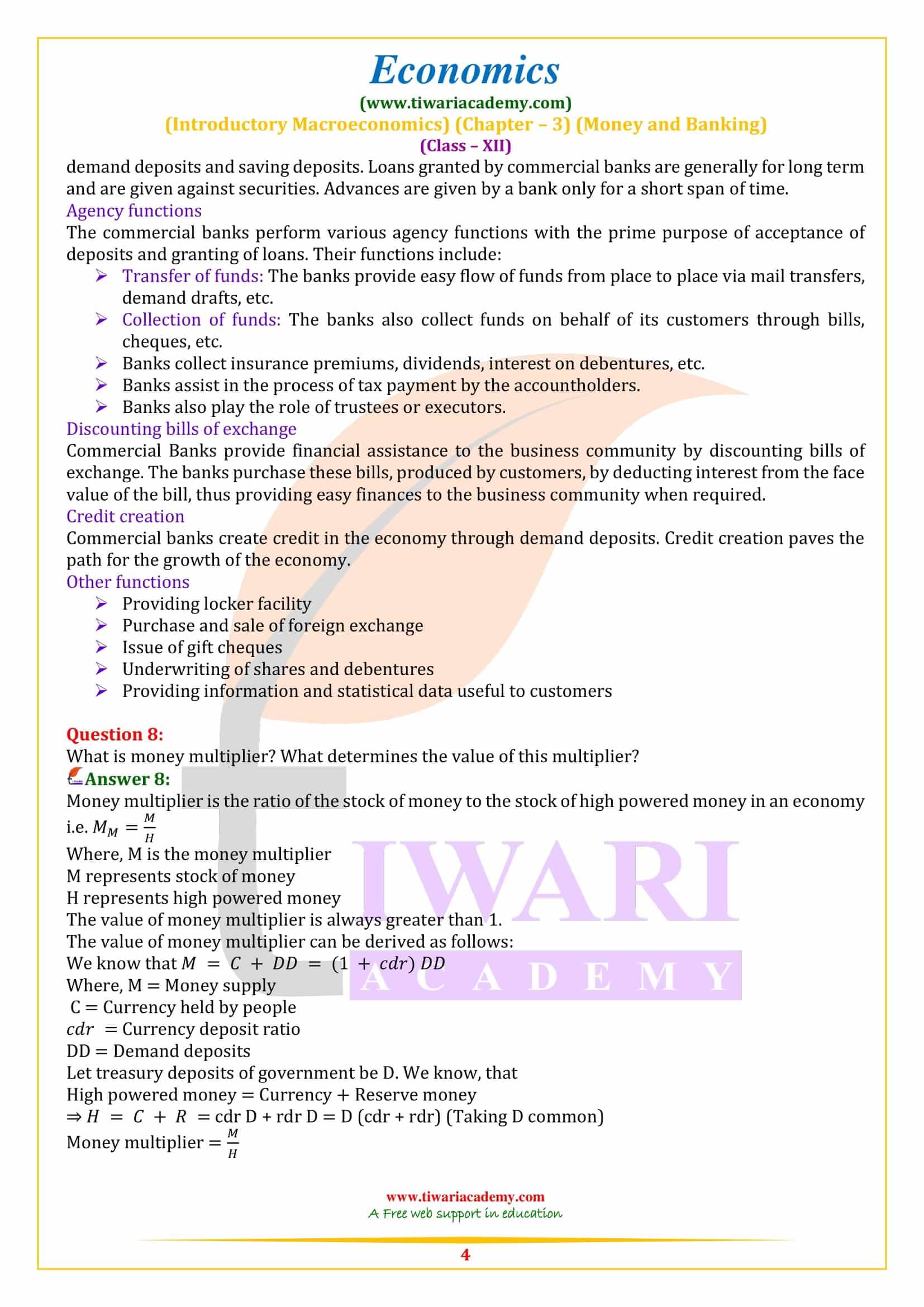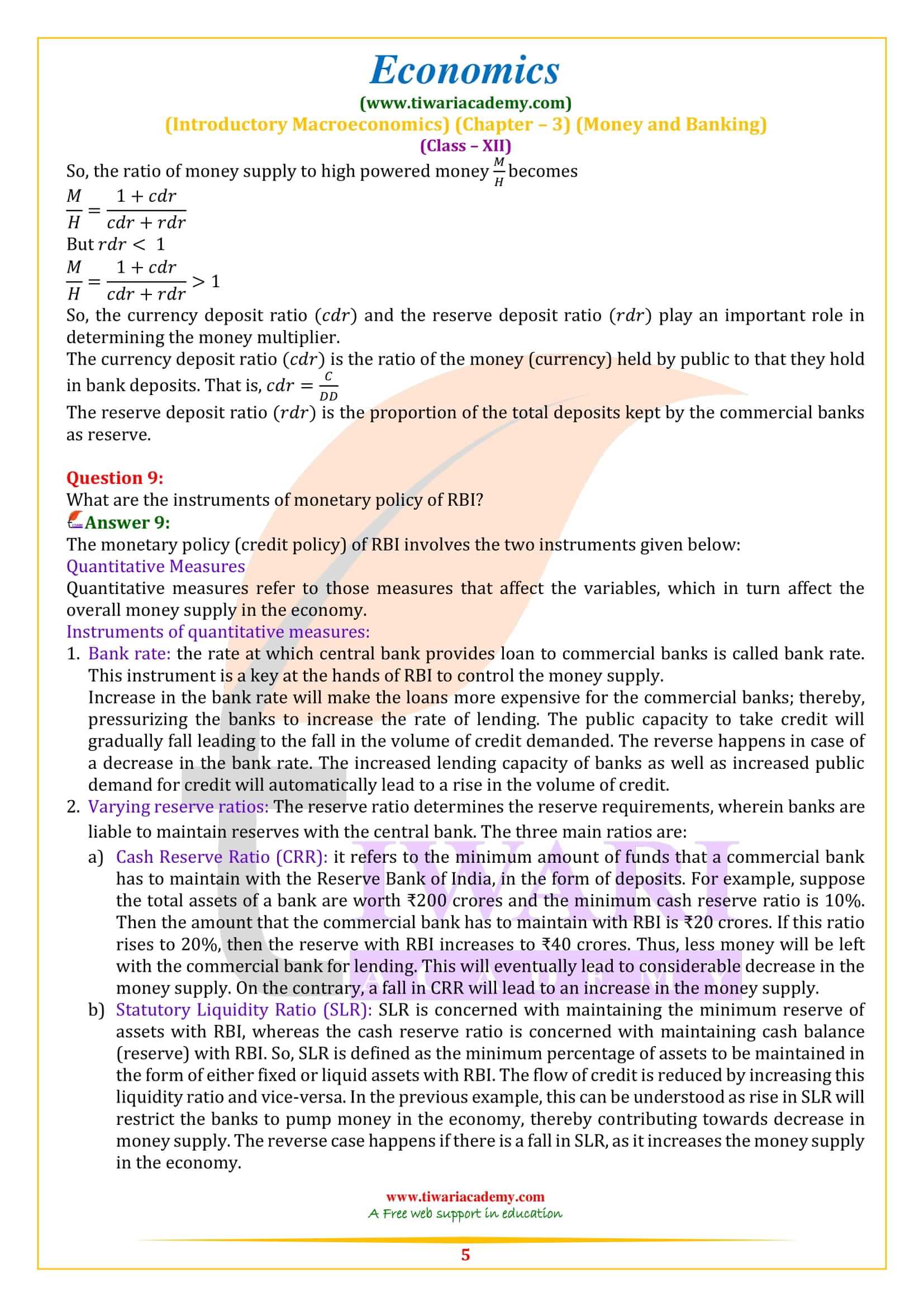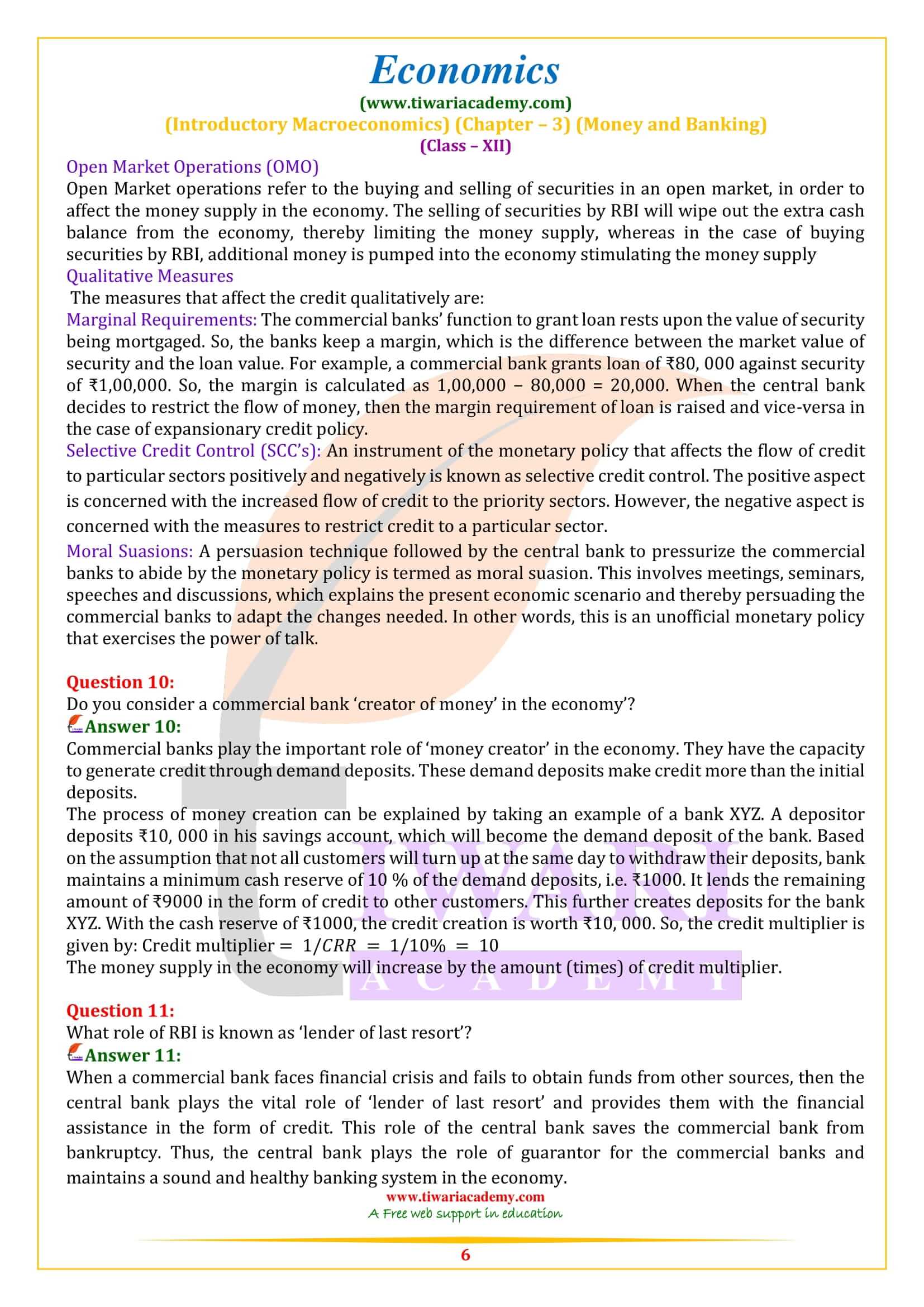NCERT Solutions for Class 12 Economics Chapter 3 Money and Banking – Macroeconomics with Case Study MCQ and important question answers for CBSE 2024-25. Class 12 Macroeconomics chapter 3 solutions are important for all the students of state board also, who are using NCERT Textbook for study.
Class 12 Economics Chapter 3 Solutions
Class 12 Economics Macroeconomics Chapter 3 Money and Banking Question Answers
Class 12 Economics – Money and Banking
Money is the commonly accepted medium of exchange. Suppose there is only one person in an economy, there cannot be any exchange of commodities, and hence, there is no role of money. If there are more than one people in an economy, but they do not take part in market transaction, money has no function to them. For example: The tribes which live in the forests, and has no connection with outer world. They eat what they hunt. They wear animal skin. Their daily need does not include any monetary transaction.
They survive on their hunting skills, and they make their houses with the wood and they use natural resources for their every need. They do not depend or we can say need money to fulfil their daily needs. Similarly, for a family living on an isolated island, money has no function for them. However, as soon as there is more than one economic agent who engage themselves in transactions through the market, money becomes an important thing for facilitating exchanges. Economic exchanges without the mediation of money are referred to as Barter Exchanges. But there are some cons of barter exchanges. Suppose you have a surplus of clothing, and you want to exchange it for rice.
So, first you have to search for a person who has a surplus of rice and also wants clothing in exchange of that. It would be very difficult to find the exact match. Sometimes it may take days or even weeks. Thus, to smoothness the transaction, an intermediate good is necessary which is acceptable to both parties. Such a good is called money. The individuals can sell their produces for money and purchase the commodities of their need using that money. This saves a lot of time as well as cut down the amount of effort made to find the right person to zero.
Functions of Money
We all know, the most important role of money is that, it acts as a medium of exchange. It is used to buy and sell things. Money also acts as a convenient unit of account. The value of all everything like commodities and services can be expressed in monetary terms, which means that whatever goods and services in the market are available for sale, they have a price. Barter exchanges becomes extremely difficult in a large economy because it will consume lots of time and costs looking for right persons to exchange their surpluses.
This system has other disadvantages too. It is difficult to calculate one’s wealth under the barter system. For example: If you have produced extra wheat which you do not wish to consume entirely by yourself. You can think or take this stock of wheat surplus as an asset for future purposes. But wheat is an item which cannot be stored beyond a certain period, it will get defected by bugs and insects. To stock this wheat, you will need a lot of space. You may have to spend considerable time and resources looking for people with a demand for wheat when you wish to exchange. This problem can be solved if you sell your wheat for money. Money does not have an expiry date.
Everyone will accept money as an exchange at any point of time. You can say that money is a store of value for individuals. Wealth can be stored in the form of money for future use and its storage costs are also considerably low. But to perform this function, the value of money should be somewhat stable. A rising price level may erode the purchasing power of money. Some assets other than money can also act as a store of value, like: gold, landed property, houses, etc. However, they may not be easily convertible and they are not accepted universally as the medium of exchange.
Demand for Money and Supply of Money
Demand for money: When people desire a certain amount of money for any transaction, it creates demand for money. The amount of money is determined by the value of transaction the people want to do, as they will need money at least equal to the value of the transaction. For greater transaction values, greater money is required, thus demanded. Since the practicality of transactions to be made depends on income, it is clear that the rise in income will lead to rise in demand for money. Also, when people keep their savings in physical form, rather than putting it in bank, the demand for money rises. But when people put their savings in a bank, they earn interest on their savings. So, the higher the interest rate goes, the demand for money in physical form goes down, as people would want to earn interest on their money by keeping it in the bank.
Supply of money: In modern times, money comprises cash and bank deposits. There are many measures of money depending on what types of bank deposits are included. These are created by a system comprising two types of institutions: Central Bank of the economy and Commercial Banks. Central Bank is a very important institution in a modern economy. Almost every country has its central bank. India got its central bank in 1935, which is ‘Reserve Bank of India’. It has several important functions like; Issuing the currency of the country, Controlling money supply of the country through various methods, etc.
Commercial Banks are the other type of institutions which are a part of the money-creating system of the economy. They accept deposits from the public and lend out part of these funds to those who want to borrow. The interest rate paid by the bank to depositors is lower than the rate charged from the borrowers. The difference between these two types of interest rate is called ‘Spread’, and is the profit earned by the bank.
How to prepare class 12 Macroeconomics chapter 3 for CBSE Board?
Class 12 Economics chapter 3 is broadly related to the determination of equilibrium in the economy. There are two approaches to find equilibrium of national income/ output. However, before trying to understand the two approaches to equilibrium, we first study the meaning and components of aggregate demand and aggregate supply- because these are the basic tools of macroeconomic study.
The two approaches of equilibrium are the aggregated demand and aggregate supply approach (C + I approach) and the saving and investment approach (S + I approach). Additionally, we study how saving curve is derived from consumption curve and vice- versa. We study what happens to the economy when equilibrium is disturbed. We also study how equilibrium can be restored.
The topic concludes the study of the concept and working of the investment multiplier. In this topic, you will have to solve a variety of numerical questions (just like the topic of National income accounting) and understand at least 5 important diagrams/ graphs.
What are the Important Concepts given in 3rd chapter of Class 12 Macroeconomics?
The following are the important concepts in this topic aggregate demand, aggregate supply, equilibrium of national income, break- even level of economy (the point where APC = C/Y=1 or where saving = 0), The consumption function and the saving functions, investment and its types (induced investment and autonomous investment), types of unemployment (frictional, seasonal, structural). For the information of students, we study types of unemployment because no economy functions at the level of full employment due to some kind of unemployment/ idle resources. We also study the working of multiplier and three formulae associated with it. We also study measures to control situation of excess demand and deficient demand through the use of monetary policies and fiscal policies.
Which questions of 12th Economics chapter 3 are good to revise during the exams?
- (i) How is equilibrium level of national income derived by AD/AS approach (C + I approach)?
(6 marks) - (ii) How is equilibrium level of national income derived by saving and Investment approach (C + I approach)? (6 marks)
- (iii) Explain the working of investment multiplier? How is multiplier related to MPC? (6 marks)
- (iv) Draw a straight line consumption curve. Mark upon it a point where APC = 1. From it derived the saving curve. (6 marks)
- (v) What is under-employment equilibrium? (or can an economy be working at less than full employment level and still be equilibrium?) Draw a neatly labelled diagram showing how national income falls at less than full employment. (6 marks)
- (vi) Show by means of a diagram the concept of inflationary gap and deflationary gap. (6 marks)
What are the main Important Abbreviations in class 12 Economics chapter 3?
(i) AD = Aggregate Demand
(ii) AS = Aggregate supply/ Aggregate Output
(iii) MPC = Marginal Propensity to Consume
(iv) APC = Average Propensity to Consume
(v) MPS = Marginal propensity to Save
(vi) APS = Average propensity to Save
